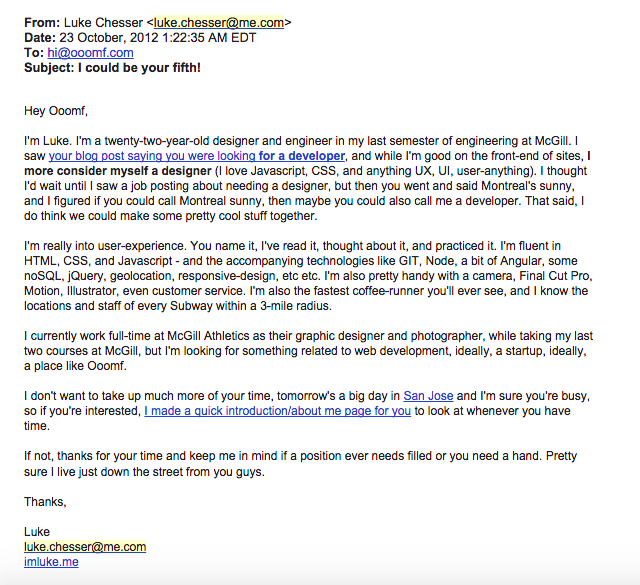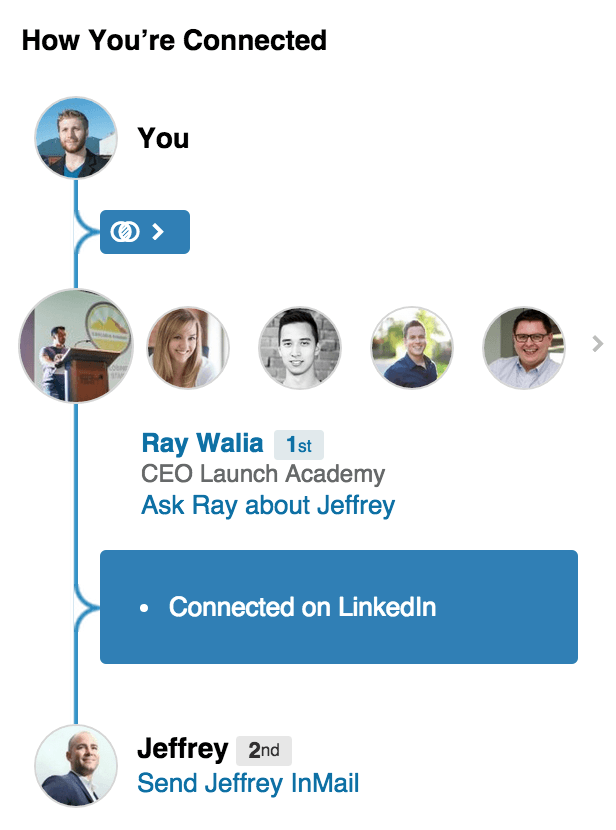
How to get an interview for a job

Employers get hundreds of applications per opening. This post outlines how to beat the odds and get fast-tracked to the interview.
If you’ve been following this series in your quest for the perfect job, you will have the following:
- A inspired and happy mind
- An accurate idea of your skills, experience and ideal job
- A custom resume and cover letter for each position.
All of those are very important. But now it’s time to get the job. This post will show you exactly how to approach the job application process to maximize your chances of success.
It covers the following:
- The traditional methods of applying for a job
- The right way to get your resume in front of the right people with a warm introduction
- How to get noticed without a warm introduction
Let’s go.
Traditional job applications
Typically, people apply to jobs in two ways.
1. The “hope for the best” method
This is the art of submitting your resume into an applicant tracking system, filling out a bunch of forms, and hoping all goes to plan.
Things rarely go to plan.
Eventually you will have to submit your resume to an ATS- but if you really want the job, save that step for much later.
ONLY apply for the job using this method if the following is true:
- You’re a PERFECT fit for the job and they’d be stupid not to call you
- You don’t care that much about the job
If you do really want the job, leaving your fate in the hands of the ATS is a big risk (at least initially). Try other methods first.
2. Direct Email
The second most common job application involves directly emailing the most relevant person in the company with an introductory email and link to your resume.
This will result in one of the following scenarios:
- That person will love you and invite you for an interview
- You will be introduced via Email to HR
- Your email will be forwarded to HR without a response
- You will get a reply telling you to apply the traditional way
- Your email will be ignored.
Options 1, 2, and 3 are good. 5 is most likely, unless you write a killer cover letter (Which you should have!).
How do I directly email a decision maker?
People always overthink this process. Remember, as much as you want the job — companies want to hire passionate, motivated people. Remember that your WORST-CASE SCENARIO is that your email is ignored. Just go for it.
Here’s how to send a direct email:
Find the hiring manager for the position (or a VP or CEO at a smaller company) through research on LinkedIn or their company website
Find their email address (here’s how) and send them a perfect introductory email.
This email should outline:
- How you can solve their problems
- Why you love their company
- Why you’re a great cultural fit
Here is an example of an effective cold email.

Source: Why I didn't look at your resume
This will be much more successful than a traditional application. However, you are still leaving much up to chance with a direct email. If you are going to apply for the job with the “hope for the best” method, you should at least try a direct email first. Most people use these methods. Don’t be most people.
The guaranteed way to land an interview
“Whenever you find yourself on the side of the majority, it is time to pause and reflect.” — Mark Twain
The previous two application methods might work — but leave too much to chance. The best way to get shortlisted for an interview is to get on the radar of the right people with a warm introduction.
A quality warm introduction is your best chance at landing the job.
What is a warm introduction?
A warm introduction is an email from a trusted third party to your target contact that introduces you. It comes in two forms:
- An email from the third party to your target contact, with you CC’d
- A forwarded email to your target contact
A warm introduction is the most powerful application method. It creates trust, brands you as a suitable candidate, and separates you from the other applicants. Click here for more detail on the warm introduction.
Asking for an introduction
1. List your target contacts
- The recruiter
- The hiring manager
- The VP or CEO (depending on company size)
These are all people you need to impress in order to get the job.
2. Find a connection
Once you know who the target contact is — you need to find a connection.
Use LinkedIn to see how you’re connected to each target contact.

#ProTip: LinkedIn Connections
If you have more than one connection to the target contact, pick the most powerful first but don’t hesitate to attack from different angles.
Data.com is another useful tool for finding contacts.
DO NOT SEND THEM AN INMAIL. It may work for business development, but not for getting hired. The closer the connection the better, but even a very loose connection is better than no connection.
Don’t be shy about asking for help — your worst-case scenario in all of these situations is an ignored email.
3. Make contact
The next step is to use your connection to make contact with the decision maker. Send your best connection the following emails:
An introduction email with a quick brief on why you’re a great fit for the job, which includes asking if you can send them your resume to forward to the target decision maker. Upon reply, send a brief paragraph explaining why you’re a great fit for the job with your resume attached.
Here’s an example introductory email:
Hi James, I’m moving on from my gig at KarmaHire and noticed Hootsuite is hiring a Growth Hacker. I helped KarmaHire increase their traffic from 10k monthly uniques to 200k with some neat hacks (including writing my own web crawler and an automated Facebook Guerilla marketing campaign). I have some ideas on how I can increase engagement and growth of their new Hootlet chrome app. Here are my top 2:
1) Add a link to share specific quotes when highlighted on web pages — ie. If you’re reading a New York Times Article, create a “click to Tweet” with any text that’s highlighted.
2) Add a feedback loop in the extension itself that gives an idea of how the last post performed and tips on optimizing the next one. Might be a bit heavy — but for people who aren’t heavy web app users it would be valuable and keep them coming back.
Growth hacking is something I absolutely love, and my plan is to be one of the top growth hackers in the world in the next 2 years. I’d love to do it at Hootsuite Labs.
I’ve attached my resume — do you think you could make an introduction to Mike if you see a fit here?
Best, Jim
What if you don’t have any direct connections to the decision maker?
If you don’t have the right connections to decision makers in the company, you’ll need to do some extra legwork, and add an extra step in the connection loop.
- Find anyone in the company you’re connected to by any degree.
- Research that person and find a closer mutual connection.
- Brainstorm a few ways that you could add value to the target contacts’ life.
Once you have your pitch down, follow the process above asking for an introduction to that person through your mutual connection.
An introduction email with a quick brief on why you should meet their contact, followed by “The Ask” An introductory email to be forwarded to the target connection.
Your goal is to meet that person for a coffee or drink. Note — you need to provide value or have something in common, or be asking for some direct advice.
Never ask someone out for coffee to “pick their brain” — That’s just a waste of everyone’s time.
What if you can’t find an introduction?
I will challenge that you’re being lazy if you can’t find any possible connection at a company. If you really cannot find a connection, here are a few more ways to get noticed.
- Attend any open event hosted by the company that your target contacts are attending. Meet them “organically”, but amaze them with your knowledge of the company. Get a business card and follow up with an email. To find events, stalk them on Twitter.
- Get featured or write for any blog that is reasonably popular and mention the company or contacts name. Once your article is published, send their CEO and recruiters a link to the article via email or Twitter. Follow up with a direct email for the job application.
- If you have a personal blog this works on a smaller scale. People love to hear about how awesome they are.
- Start an interview series on any reasonably popular blog and interview your target contacts. Leverage those relationships.
- If there is someone at the company with a public profile (Ie. They write a blog, write for a newspaper, or speak publicly), build a relationship by reaching out about an article they wrote and why you liked it. Continue the correspondence by occasionally reaching out with information they might find valuable.
A real life case study
The following is a completely case study from Veronica, who was transitioning from a marketing/data analyst role at a small startup to a project management role at a larger company.
The company was looking to fill the a project management role. Veronica is a very awesome person, but had no experience in this field.
Veronica did some research and found out that her former CEO (from 2 jobs ago) was well connected to Carrie, a lead project manager at the new company. She sent Ken an email asking for an introduction to Carrie.
Ken delivered.

Veronica quickly followed up

That warm introduction (plus some really solid references), helped her land the job after an extensive interview process. Get started now
You’ll notice a few common themes here. If you’re constantly growing your network, your relationships, and your skills — each job search becomes easier. The best time to maintain and grow your relationships is when you don’t need them.
The other key point is to always deliver great work and stay on good terms with people. The world is too small to have a bad reputation.
With that in mind, go get that job!

Written By
James Clift
Co-Founder & Director
James is an entrepreneur and the Co-Founder of VisualCV. He has spent the last 10 years building businesses, from window cleaning to software. His passion is helping individuals create the careers they want.

These ten questions are sure to impress the employer at your next job interview
November 13, 2020
Read Post

Community Success Manager & CV Writing Expert

You shouldn't “wing it” in a job interview. Research, planning, and practice are all important parts of giving great answers.
November 6, 2020
Read Post

Community Success Manager & CV Writing Expert

As more and more of the job interview process moves online, it is important to learn how to give a great video interview.
February 12, 2021
Read Post

Community Success Manager & CV Writing Expert
Copyright ©2025 Workstory Inc.